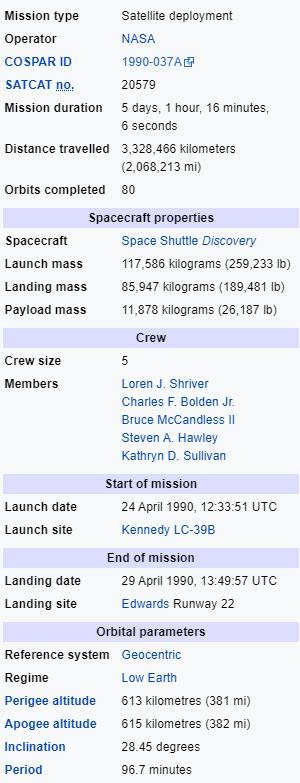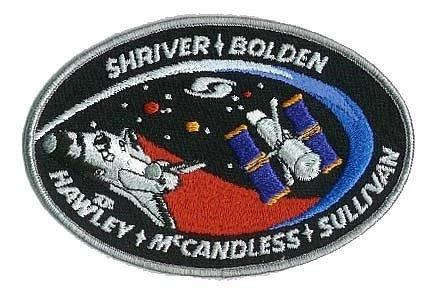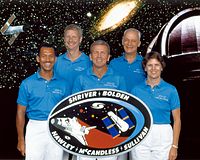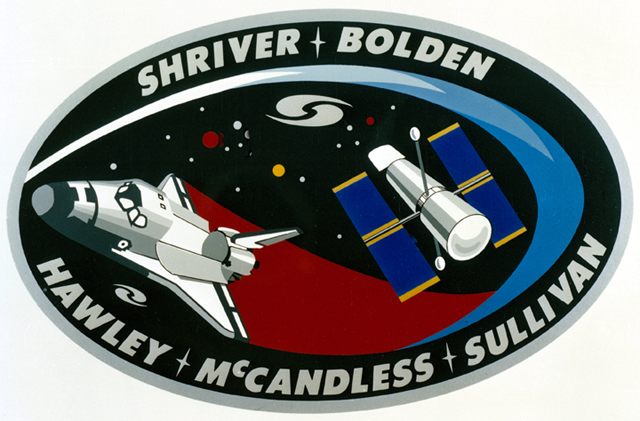Loren J. Shriver
(Second Space Flight)
Charles F. Bolden Jr.
(Second Space Flight) Mission Specialist 1:
Steven A. Hawley
(Third Space Flight) Mission Specialist 2:
Bruce McCandless II
(Second Space Flight) Mission Specialist 3:
Kathryn D. Sullivan
(Second Space Flight)
STS-31 was the thirty-fifth mission of the American Space Shuttle Programme, which launched the Hubble Space Telescope astronomical observatory into Earth orbit. The mission used the Space Shuttle Discovery, which lifted off from Launch Pad 39B on 24 April 1990 from Kennedy Space Centre, Florida.
Discovery's crew deployed the telescope on 25 April, and spent the rest of the mission tending to various scientific experiments in the shuttle's payload bay and operating a set of IMAX cameras to record the mission. Discovery's launch marked the first time since January 1986 that two Space Shuttles had been on the launch pad at the same time - Discovery on 39B and Columbiaon 39A.
A free template by Lucknowwebs.com for WYSIWYG WebBuilder 8
Astronauts:
The Space Shuttle Missions
STS-31 (R)
Study
Research
Main Index
Space Cosmology
Science Research
*
About
Science Research
Science Theories
Desk
Site Map
BookShelf
Copyright © by Nigel G Wilcox · All Rights reserved · E-Mail: ngwilcox100@gmail.com
Designed by Nigel G Wilcox
Powered By AM3L1A
Pages within this section: USA Shuttle Mission Flights
STS-31
Pages within this section:
9
M
8
SM
Sub-Menu
menu
-
26
27
28
29
30
31
32
Command Pilot:
Pilot:


The main purpose of this mission was to deploy Hubble. It was designed to operate above the Earth's turbulent and obscuring atmosphere to observe celestial objects at ultraviolet, visible and near-infrared wavelengths. The Hubble mission was a joint NASA-ESA effort going back to the late 1970s.The rest of the mission was devoted to photography and onboard experiments. To launch HST into an orbit that guaranteed longevity, Discovery entered an orbit of around 613km by 615km. At one point during the mission, Discovery briefly reached an apogee of 621 kilometres (386 mi), the highest altitude ever reached by a Shuttle orbiter. The record height also permitted the crew to photograph Earth's large-scale geographic features not apparent from lower orbits. Motion pictures were recorded by two IMAX cameras, and the results appeared in the 1994 IMAX film Destiny in Space. Experiments included a biomedical technology study, advanced materials research, particle contamination and ionizing radiation measurements, and a student science project studying zero gravity effects on electronic arcs. Discovery's reentry from its higher than usual orbit required a deorbit burn of 4 minutes and 58 seconds, the longest in Shuttle history up to that time.
During the deployment of Hubble, one of the observatory's solar arrays stopped as it unfurled. While ground controllers searched for a way to command HST to unreel the solar array, Mission Specialists McCandless and Sullivan began preparing for a contingency spacewalk in the event that the array could not be deployed through ground control. The array eventually came free and unfurled through ground control, while McCandless and Sullivan were pre-breathing inside the partially depressurized airlock.
Secondary payloads included the IMAX Cargo Bay Camera (ICBC) to document operations outside the crew cabin and a handheld IMAX camera for use inside the orbiter. Also included were the Ascent Particle Monitor (APM) to detect particulate matter in the payload bay; a Protein Crystal Growth (PCG) experiment to provide data on growing protein crystals in microgravity, Radiation Monitoring Equipment III (RME III) to measure gamma ray levels in the crew cabin; Investigations into Polymer Membrane Processing (IPMP) to determine porosity control in the microgravity environment, and an Air Force Maui Optical Site (AMOS) experiment.
The mission marked the flight of an 11-pound human skull, which served as the primary element of "Detailed Secondary Objective 469", also known as the In-flight Radiation Dose Distribution (IDRD) experiment. This joint NASA/DoD experiment was designed to examine the penetration of radiation into the human cranium during spaceflight. The female skull was seated in a plastic matrix, representative of tissue, and sliced into ten layers. Hundreds of thermo-luminescent dosimeters were mounted in the skull's layers to record radiation levels at multiple depths. This experiment, which also flew on STS-28 and STS-36, was located in the shuttle's mid-deck lockers on all three flights, recording radiation levels at different orbital inclinations.
STS-31 was launched on 24 April 1990 at 8:33:51 am EDT. A launch attempt on 10 April was scrubbed at T-4 minutes for a faulty valve in auxiliary power unit (APU) number one. The APU was eventually replaced and the Hubble Space Telescope's batteries were recharged. On launch day, the countdown was briefly halted at T-31 seconds when Discovery's computers failed to shut down a fuel valve line on ground support equipment. Engineers ordered the valve closed and the countdown continued. The primary payload was the Hubble Space Telescope (HST), deployed in a 380 statute mile (612 kilometres (380 mi)) orbit. The shuttle's orbit in this mission was its highest orbit up to that date, in order for HST to be released near its operational altitude well outside the atmosphere. Discovery orbited the Earth 80 times during the mission.
Discovery deploys the Hubble Space Telescope
Data Courtesy Wikipedia.org















